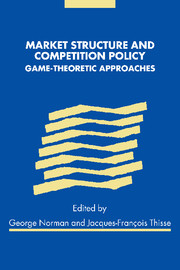Book contents
- Frontmatter
- Contents
- List of figures
- List of tables
- List of contributors
- Louis Phlips: a brief biography
- Introduction
- 1 Competition policy and game-theory: reflections based on the cement industry case
- 2 Legal standards and economic analysis of collusion in EC competition policy
- 3 A guided tour of the Folk Theorem
- 4 Predatory pricing and anti-dumping
- 5 Should pricing policies be regulated when firms may tacitly collude?
- 6 Tougher price competition or lower concentration: a trade-off for anti-trust authorities?
- 7 The strategic effects of supply guarantees: the raincheck game
- 8 Product market competition policy and technological performance
- 9 On some issues in the theory of competition in regulated markets
- 10 Modelling the entry and exit process in dynamic competition: an introduction to repeated-commitment models
- 11 Coordination failures in the Cournot approach to deregulated bank competition
- 12 How the adoption of a new technology is affected by the interaction between labour and product markets
- Index
10 - Modelling the entry and exit process in dynamic competition: an introduction to repeated-commitment models
Published online by Cambridge University Press: 22 September 2009
- Frontmatter
- Contents
- List of figures
- List of tables
- List of contributors
- Louis Phlips: a brief biography
- Introduction
- 1 Competition policy and game-theory: reflections based on the cement industry case
- 2 Legal standards and economic analysis of collusion in EC competition policy
- 3 A guided tour of the Folk Theorem
- 4 Predatory pricing and anti-dumping
- 5 Should pricing policies be regulated when firms may tacitly collude?
- 6 Tougher price competition or lower concentration: a trade-off for anti-trust authorities?
- 7 The strategic effects of supply guarantees: the raincheck game
- 8 Product market competition policy and technological performance
- 9 On some issues in the theory of competition in regulated markets
- 10 Modelling the entry and exit process in dynamic competition: an introduction to repeated-commitment models
- 11 Coordination failures in the Cournot approach to deregulated bank competition
- 12 How the adoption of a new technology is affected by the interaction between labour and product markets
- Index
Summary
Introduction
This chapter provides an introduction to game-theoretic models of dynamic competition based on repeated commitments (Gromb, Ponssard and Sevy, 1997). The following stylised facts about entry motivate this approach (Geroski, 1995):
entry is mostly associated with innovative processes, higher productivity and a context in which the current industry structure and technology are out of line with exogenous changes
entrant firms suffer a high-rate of failure and an eventual success can hardly be assessed before a period of 5–10 years
entry of innovative firms, whenever successful, leads to the exit of inefficient incumbents.
A number of econometric studies support these facts. Detailed industry analyses illustrate further how the selective reactions to entry may depend on the relative position of the competing firms (Scherer, 1992). These industry analyses focus on the entry of foreign rivals into home markets in a context of increased international competition. More generally, firms enjoying natural markets due to transportation or switching costs may face a similar context when these costs drop due to some external changes.
Under such circumstances, the reactions of incumbent firms appear to be selective: some firms prefer to progressively give up their market share, milking their current business, while others react aggressively through large R&D investments so as to catch back their rivals. According to Scherer, RCA adopted a milking strategy in television sets while Gillette strongly reacted in wet-shaving apparatus.
- Type
- Chapter
- Information
- Market Structure and Competition PolicyGame-Theoretic Approaches, pp. 215 - 231Publisher: Cambridge University PressPrint publication year: 2000
- 1
- Cited by



